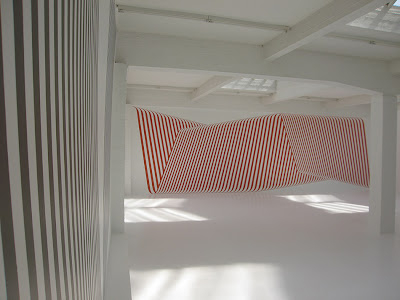- Get link
- X
- Other Apps
Featured Post
- Get link
- X
- Other Apps


Haggerty has become known in recent years for paintings that express the formalist vocabulary of abstraction in a new way. The principle of serial composition can be discerned in Haggerty’s work: light-colored stripes alternate with darker ones to form regular, often horizontal arrangements, which also have a pattern-like quality due to their dense structure. This would not seem particularly remarkable were it not for the fact that Haggerty breaks this linear formation at the edges of the painting — and occasionally also at the symmetrical center of the composition—by bending the lines in a different direction as they approach the boundaries of the painting support. This has a crucial effect on the overall pictorial appearance, in that it immediately transforms the planimetric structure of the painted motif into an illusory perception of three-dimensionality within the image. (Friedrich Meschede) The surface seems to continue beyond the boundaries of the picture support, with the result that the two-dimensional paintings suddenly resemble painted volumes or reflect the illusory perception of a third dimension back onto the pictorial motif. Haggerty’s vibrant wall paintings conjure nostalgic associations from the mustard yellow and avocado décor of the 1960s and 1970s, to optical art, to the precise lines of sugar icing on pastries. He combines humorous and historical references to form abstract compositions that electrify and manipulate the space around them. Biography: Terry Haggerty was born in London in 1970 and lives in New York. He studied at the Southend School of Art, Essex, England, and the Cheltenham School of Art, Cheltenham, England. His work has been featured in solo exhibitions at Kuttner Siebert, Berlin; Grimm Rosenfeld, Munich; Konsortium, Düsseldorf; Aschenbach & Hofland, Amsterdam; and Riva Gallery, New York. He has participated in group exhibitions at Galerie Max Hetzler, Berlin; Sikkema Jenkins & Co., New York; the Aldrich Contemporary Art Museum, Ridgefield, Connecticut; and Artists Space, New York. Haggerty’s work was also included in the Prague Biennale (2003) and the Venice Biennale (1994).
Source
- Get link
- X
- Other Apps
Comments